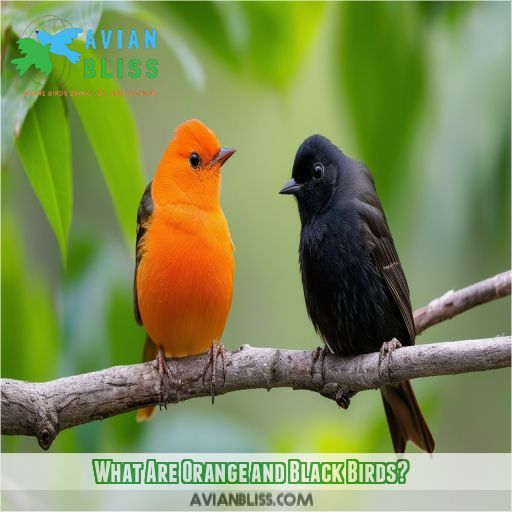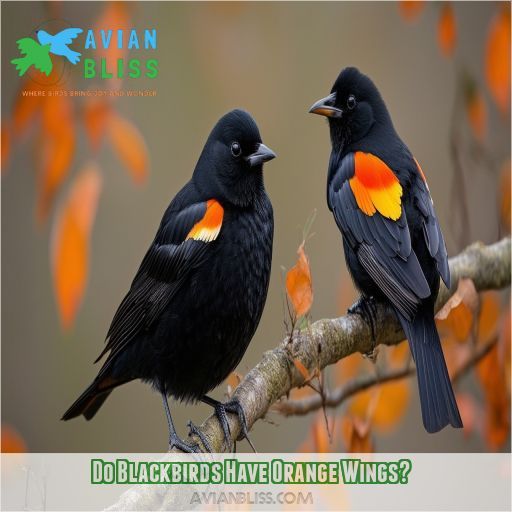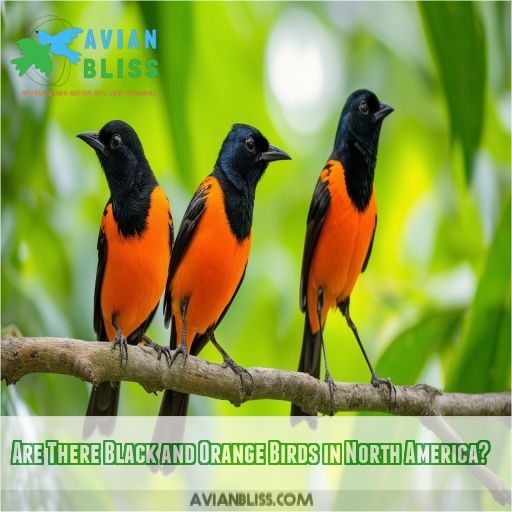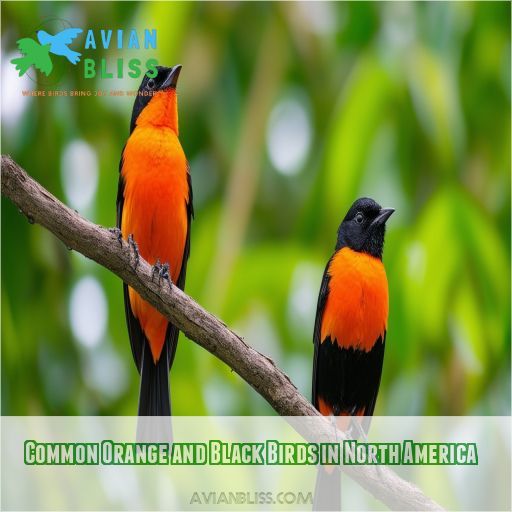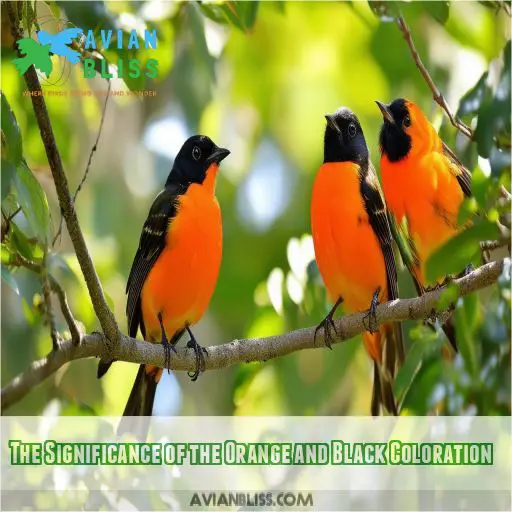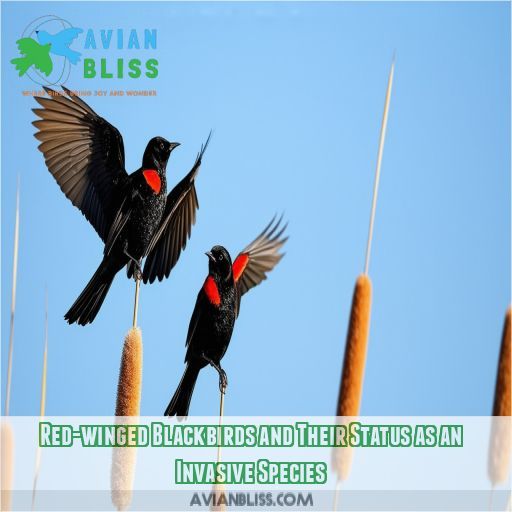This site is supported by our readers. We may earn a commission, at no cost to you, if you purchase through links.
 Prepare to be amazed by the hidden world of orange and black birds.
Prepare to be amazed by the hidden world of orange and black birds.
You’re about to discover 10 stunning species that’ll challenge your perception of avian beauty.
From vibrant orioles to elusive tanagers, these feathered wonders are nature’s masterpieces.
You’ll learn where to find them, how to identify their distinctive markings, and why their unique coloration matters.
Get ready to expand your bird-watching knowledge and learn more about these fascinating creatures.
Your journey into the world of orange and black birds begins now.
Table Of Contents
- Key Takeaways
- What Are Orange and Black Birds?
- Do Blackbirds Have Orange Wings?
- Are There Black and Orange Birds in North America?
- Common Orange and Black Birds in North America
- The Significance of the Orange and Black Coloration
- Baltimore Oriole Vs Bullock’s Oriole Differences
- Migration Habits of Orange and Black Birds
- Attracting Orange and Black Birds to Your Backyard
- Identifying Bird Species With Black and Orange Colors
- Red-winged Blackbirds and Their Status as an Invasive Species
- Frequently Asked Questions (FAQs)
- What are orange and black birds?
- Do blackbirds have orange wings?
- What is the world of Orange and black birds?
- Are there black and orange birds in North America?
- What are some common orange and black birds found in North America?
- What is the significance of the orange and black coloration of these birds?
- What is the difference between a Baltimore oriole and a Bullock’s oriole?
- Are all orange and black birds migratory?
- Can you attract orange and black birds to your backyard?
- What kind of bird has black and orange?
- What bird has an orange and black face?
- What is the orange and black bird that looks like a robin?
- Are Red-winged Blackbirds an invasive species?
- How do orange and black birds camouflage themselves?
- What predators commonly target orange and black birds?
- Do orange and black birds have any unique mating rituals?
- How long do orange and black birds typically live?
- Are there any endangered species of orange and black birds?
- Conclusion
Key Takeaways
- Nature’s got a flair for the dramatic! Orange and black birds are like living fireworks, adding a pop of color to your backyard and beyond. From the Baltimore Oriole’s fiery plumage to the Red-winged Blackbird‘s flashy shoulder patches, these feathered fashionistas are sure to turn heads.
- Don’t judge a bird by its cover – those flashy colors aren’t just for show. These avian smarty-pants use their vibrant hues for everything from attracting mates to warning predators. It’s like they’re wearing a "don’t mess with me" t-shirt and a "hey there, good lookin’" sign all at once!
- Fancy a bit of globe-trotting? Many of these orange and black beauties are world-class travelers, migrating thousands of miles each year. They’re like the jet-setters of the bird world, trading in their frequent flyer miles for warmer climes and better buffets.
- Want to roll out the red carpet for these colorful characters? Turn your backyard into a five-star bird resort! With the right mix of feeders, plants, and water features, you’ll have a front-row seat to nature’s most dazzling show. Just don’t forget the popcorn!
What Are Orange and Black Birds?
Have you ever marveled at the striking combination of orange and black in birds?
These eye-catching creatures are nature’s living works of art, evolved to stand out in their environments.
The vibrant orange and deep black serve various purposes, from attracting mates to warning predators.
You’ll find stunning examples like the baltimore oriole, orchard oriole, hooded oriole, altamira oriole, and spot-breasted oriole.
These species showcase the power of color in the avian world.
The contrast between orange and black isn’t just for show; it’s a reflection of evolutionary adaptations.
Each hue carries significance, whether it’s for camouflage, communication, or thermoregulation.
As you explore these feathered wonders, you’ll discover how their coloration plays a key role in their survival and success.
Ready to learn more about the fascinating world of orange and black birds?
Do Blackbirds Have Orange Wings?
You might be surprised to learn that some blackbirds do indeed have orange wings!
The most famous example is the red-winged blackbird, a common sight across North America. Despite its name, this striking species boasts vibrant orange-red patches on its wings, contrasting beautifully with its jet-black plumage.
These eye-catching markings aren’t just for show – they play a key role in attracting mates and establishing territory.
When you’re out birdwatching, keep an eye out for these distinctive orange patches. They’re like nature’s own traffic signals, flashing brightly as the bird takes flight or displays.
It’s interesting to note that female red-winged blackbirds don’t share this flashy feature, sporting a more subdued brown coloration instead.
This difference in appearance between males and females, called sexual dimorphism, is common in many bird species and adds another layer of intrigue to bird identification.
Are There Black and Orange Birds in North America?
While blackbirds with orange wings are rare, North America boasts a stunning array of black and orange birds. You’ll find these eye-catching species throughout the continent, from coastal regions to mountain forests. Orioles, tanagers, and even the familiar American robin sport this striking color combination. These birds aren’t just pretty to look at; their vibrant plumage serves important purposes in nature.
Here’s what makes these black and orange birds so interesting:
- Their colors flash like living flames against green foliage
- They stand out during courtship displays, attracting potential mates
- The contrast helps camouflage them from predators in dappled sunlight
Many of these species, like the Baltimore and Bullock’s orioles, are migratory. They journey thousands of miles each year, bringing their fiery hues to different parts of the continent. Keep your eyes peeled – you might spot one of these beauties in your own backyard!
Common Orange and Black Birds in North America
You’ll find an array of stunning orange and black birds across North America.
The iconic northern cardinal sports a vibrant red plumage with black accents.
Orioles, like the Baltimore and Bullock’s species, dazzle with their bright orange bodies and contrasting black wings.
Keep an eye out for the American redstart, a small warbler with fiery orange patches on its jet-black feathers.
The black-headed grosbeak boasts a striking combination of orange breast and black head, while the western tanager flaunts a flame-colored head atop its yellow body.
Don’t forget about the red-winged blackbird, whose glossy black feathers are offset by brilliant red shoulder patches.
These birds inhabit various habitats, from open fields to dense forests.
Learning to identify them can turn your backyard or local park into a colorful avian paradise.
The Significance of the Orange and Black Coloration
Now that you’re familiar with common orange and black birds, let’s get into the fascinating world of their coloration.
You might wonder why these birds sport such striking hues. Nature’s not just playing dress-up; there’s a method to this avian madness.
The vibrant orange acts as a warning to predators, screaming "I’m not tasty!" It’s like a bird’s version of a "Beware of Dog" sign.
But here’s the kicker: that same flashy plumage can also serve as camouflage. In dappled sunlight, these colors break up the bird’s outline, making it harder for predators to spot.
It’s a clever survival strategy that’s evolved over millennia.
Understanding this color significance isn’t just cool; it’s key for bird identification and conservation efforts.
Baltimore Oriole Vs Bullock’s Oriole Differences
While both Baltimore and Bullock’s Orioles sport striking orange and black plumage, they’re not two peas in a pod.
You’ll spot Baltimore Orioles east of the Rockies, while their Bullock’s cousins rule the roost in the west.
Color-wise, Baltimore males flaunt a jet-black head and back, contrasting with their fiery orange breast. Bullock’s boys, however, rock a more orange head with a distinctive black eye-line.
Ladies of both species play it cool with subdued yellows and grays.
As for their homes, Baltimore Orioles fancy deciduous woodlands and suburban parks, while Bullock’s prefer open woodlands near water.
Both species are suckers for sweet treats, so hanging bird feeders with fruit or nectar might just turn your backyard into an oriole hotspot.
Keep your eyes peeled for these feathered fashionistas!
Migration Habits of Orange and Black Birds
You’ll be amazed by the incredible journeys orange and black birds undertake each year.
These feathered travelers follow specific migration patterns, timing their trips with uncanny precision.
The eastern towhee and spotted towhee, for instance, make short-distance migrations, while the scarlet tanager takes on a more ambitious route.
Blackburnian warblers are long-distance champs, flying from North America to South America every fall.
These birds navigate using a combination of celestial cues, magnetic fields, and landmark recognition.
Migration timing varies, with some species leaving as early as August and others waiting until late fall.
The flame-colored tanager, a year-round resident in parts of its range, shows how diverse migration strategies can be.
As seasons change, keep an eye out for these stunning travelers passing through your area – you might just witness a colorful spectacle in the sky!
Attracting Orange and Black Birds to Your Backyard
Want to turn your backyard into a vibrant oasis for orange and black birds? It’s easier than you think!
Start by setting up a variety of bird feeders to cater to different species. Offer a mix of seeds, fruits, and nectar to attract beauties like the Baltimore oriole, vermilion flycatcher, and Bullock’s oriole.
Don’t forget about natural food sources, too. Plant native flowers, shrubs, and trees that produce berries or attract insects. These’ll provide a buffet for yellow-headed blackbirds and northern red bishops.
Create a welcoming environment by adding birdhouses and water features. Mimic their natural habitats with diverse vegetation and open spaces.
Identifying Bird Species With Black and Orange Colors
Identifying black and orange birds can be a thrilling challenge.
You’ll want to focus on their unique color patterns, which often serve as nature’s ID cards.
The western spindalis, with its striking black-and-orange head stripes, is a real showstopper.
Don’t confuse it with the brambling, though – this European visitor sports a rusty-orange breast and black-spotted wings.
For a true stunner, keep an eye out for the varied thrush‘s bold orange and slate-blue plumage.
Bullock’s oriole might catch your eye with its fiery orange body and black-and-white wings.
And if you spot a tiny bird that looks like it’s on fire, you’ve likely encountered the vermilion flycatcher.
With practice, you’ll become a pro at spotting these feathered jewels in no time!
Red-winged Blackbirds and Their Status as an Invasive Species
You might be surprised to learn that Red-winged Blackbirds, those striking black birds with vibrant red and yellow shoulder patches, are considered invasive in some parts of North America.
While native to the continent, their population has exploded due to human-altered landscapes.
These adaptable birds have a wingspan of up to 15 inches and can wreak havoc on crops, outcompeting other species for resources.
Their impact on ecosystems is a hot topic among bird watchers and conservationists alike.
Despite their invasive status, Red-winged Blackbirds remain a common sight in wetlands and fields across the continent.
Their distinctive "conk-la-ree" call is a familiar sound to many.
As you observe these beautiful creatures, remember that their presence, while interesting, can have far-reaching consequences for local wildlife and agriculture.
Frequently Asked Questions (FAQs)
What are orange and black birds?
You’ll find various bird species sporting vibrant orange and black plumage. These eye-catching colors often serve as mating displays or warnings to predators. Some common examples include orioles, American redstarts, and towhees. They’re a treat for birdwatchers!
Do blackbirds have orange wings?
You might be surprised, but some blackbirds do have orange wings! Red-winged blackbirds, common in North America, sport bright red-orange patches on their wings. These vibrant marks stand out against their otherwise jet-black plumage.
What is the world of Orange and black birds?
Birds of a feather flock together, and you’ll find a vibrant world of orange and black avians. You’re exploring a place where flashy orioles, striking grosbeaks, and elegant tanagers showcase nature’s artistry through their bold plumage.
Are there black and orange birds in North America?
Yes, you’ll find several striking black and orange birds in North America. Look for Baltimore Orioles, American Redstarts, and Red-winged Blackbirds. These vibrant species add a splash of color to forests, wetlands, and even your backyard feeders.
What are some common orange and black birds found in North America?
You’ll spot several striking orange and black birds in North America. Common ones include the Baltimore Oriole, Red-winged Blackbird, American Redstart, and Bullock’s Oriole. Each has unique patterns, making them a delight for birdwatchers to identify and observe.
What is the significance of the orange and black coloration of these birds?
You’d think nature’s playing dress-up, but there’s method to this madness. Orange and black coloration isn’t just for show. It’s a survival tactic, helping with mate attraction, predator warning, and camouflage. Evolution’s got style, folks!
What is the difference between a Baltimore oriole and a Bullock’s oriole?
You’ll notice Baltimore orioles have black heads and backs with orange bellies, while Bullock’s orioles sport orange faces with black crowns. Their ranges differ too – Baltimore’s in the east, Bullock’s out west. They’re closely related but distinct species.
Are all orange and black birds migratory?
Coincidentally, you’ve stumbled upon a fascinating question! Not all orange and black birds migrate. While many do, some species are year-round residents. It depends on factors like habitat, food availability, and adaptability to seasonal changes.
Can you attract orange and black birds to your backyard?
You can attract colorful birds to your yard by offering diverse food options. Set up feeders with seeds, fruits, and nectar. Plant native berry bushes and flowering plants. Provide water sources and nesting materials for added appeal.
What kind of bird has black and orange?
You’ll find several species with striking black and orange plumage. Red-winged blackbirds, Baltimore orioles, and American redstarts are common examples. These eye-catching birds often inhabit woodlands, wetlands, and gardens across North America, brightening your backyard with their vibrant colors.
What bird has an orange and black face?
You’ll find several birds with orange and black faces. The Baltimore Oriole’s striking appearance features a black head with vibrant orange cheeks and throat. The Blackburnian Warbler also sports a distinctive orange face with black stripes.
What is the orange and black bird that looks like a robin?
Like a winged Halloween treat, the American Robin sports a striking orange breast and black head. You’ll spot this familiar backyard bird hopping across lawns, its plump figure and cheerful song a welcome sight in spring.
Are Red-winged Blackbirds an invasive species?
No, Red-winged Blackbirds aren’t invasive. They’re native to North America and play a key role in ecosystems. You’ll often spot these striking birds in wetlands and marshes, where they contribute to insect control and seed dispersal.
How do orange and black birds camouflage themselves?
Like chameleons of the sky, you’ll find orange and black birds master the art of blending in. They utilize disruptive coloration, breaking up their outline against varied backgrounds. Their patterns confuse predators, providing key protection in diverse habitats.
What predators commonly target orange and black birds?
You’ll face threats from hawks, falcons, and owls as primary aerial predators. Snakes and small mammals like raccoons target your nests. Domestic cats pose a significant danger, especially in urban areas. Stay vigilant to survive these diverse threats.
Do orange and black birds have any unique mating rituals?
You’ll find many bird species engage in elaborate courtship displays. Males often show off vibrant plumage, perform aerial acrobatics, or present gifts to potential mates. These rituals help attract partners and demonstrate fitness for reproduction.
How long do orange and black birds typically live?
Like a phoenix rising, you’ll marvel at their longevity. Birds typically live 3-5 years in the wild, but some species can reach 10-20 years. Factors like diet, habitat, and predation influence their lifespan.
Are there any endangered species of orange and black birds?
You’ll find several endangered orange and black birds. The Bahama Oriole faces critical threat, while the Streak-backed Oriole’s vulnerable. Conservation efforts are key for these species’ survival. Keep an eye out for their vibrant plumage in protected habitats.
Conclusion
Like brushstrokes on nature’s canvas, orange and black birds paint our world with vibrant hues.
You’ve now explored 10 stunning species, from the iconic Baltimore Oriole to the elusive Varied Thrush.
These feathered marvels aren’t just eye-catching; their coloration plays important roles in survival and reproduction.
By understanding their habitats, migration patterns, and behaviors, you’re better equipped to spot and appreciate these avian wonders.
Whether you’re a seasoned birder or novice enthusiast, the world of orange and black birds offers endless discoveries and delights.

